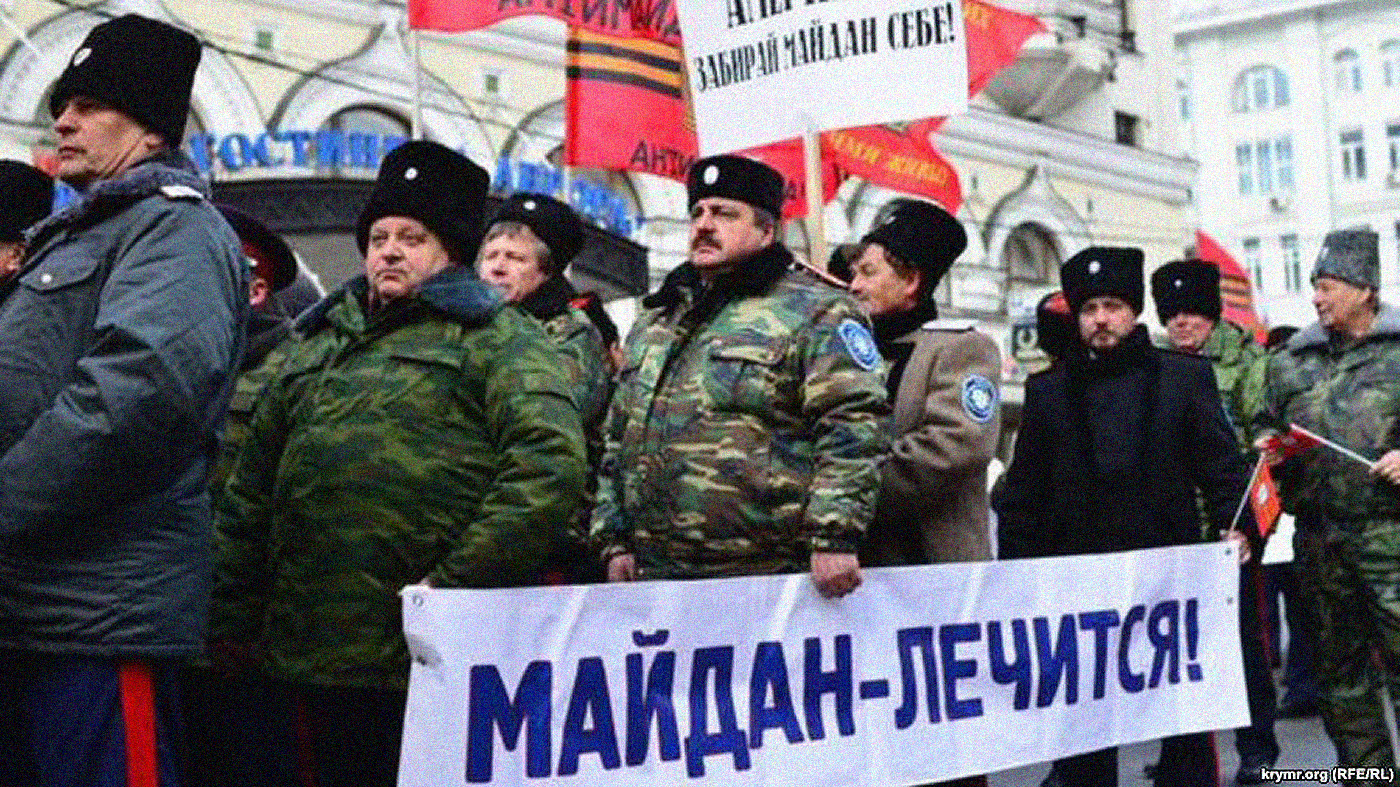— The Extraordinary Adventures of Guy Fawkes

For the revolution to happen, everything must be done to prevent it.
Cunning of speech art thou! But I am slow
To learn of thee, whom I have found my foe.
—Sophocles, Oedipus Rex
If there has been anything consistent about the extremely eclectic ideology of the post-Soviet Russian state in the past decade, it can be described with one idea: anti-revolution. This is not to be confused with counterrevolution. Counterrevolution, as the term has been used since the end of the eighteenth century, has always been mentioned in the same breath as revolution.1See Joseph de Maistre, Considerations on France (Cambridge: Cambridge University Press, 1994). It follows revolution and seeks to cancel new political and social forms that have very little in common with the pre-revolutionary old order. But while counterrevolution emerged as a new force capable of destroying the existing revolution, anti-revolution tries to prevent an imaginary revolution whose terrible specter constantly pursues the ruling powers and heralds their demise.
This approaching imaginary revolution doesn’t have obvious roots in society, and it lacks an apparent strong-willed political subject—in fact, the majority of its potential future participants know nothing about it. But this imagined revolution lives a full life of its own in the consciousness of state leadership. And it has been outlined by experts in dozens of documents. Government intelligence agencies have pinpointed the circumstances under which it will surely occur, and police forces have found their cause in preparing to meet it head-on when it erupts.
Since 2004, after the first Maidan uprising in Kyiv, the struggle against this revolutionary threat had become the definitive motif of propaganda in Russia, precipitating the creation of a full infrastructure of law enforcement agencies (such as the General Ministry for Combatting Extremism and the Investigative Committee), whose work consists predominantly of anti-revolutionary prophylaxis. These agencies are aided by a constantly updated body of repressive laws, and though their new bureaucracy often overlaps with older institutions, they are aided by a constantly improving and expanding range of tools to prevent revolution.2See President Putin’s latest bid to shut down “undesirable” foreign and international organizations: “Federal Council approved the law on ‘undesirable’ foreign organizations,” Gazeta, May 20, 2015 → And yet: when the potential revolutionaries dwindle in number, when the public sphere is more reliably controlled, when the population is even more firmly gripped by conservatism and fear of change, the leadership only grows more convinced that the revolution is just about to reach their doorstep.
Today, after decades of struggle against “the orange threat,” after the defeat of the organized political opposition, after the aggressive patriotic turn of Putin’s “third term,” after the reaction to Maidan 2014, after the war in Ukraine and the criminalization of practically any form protest, it seems that the peak of anti-revolutionary action is still far off. But this is far from the truth—in fact, this is just the beginning.

Revolution and Conspiracy
The repressions and prohibitions generated by the government’s anti-revolutionary activity are part of an endless, large-scale investigation whose goal has always been to establish the source of the revolutionary threat. Extremists, disloyal elements within the elite, and provocateurs in the media and cultural sphere are only pieces of the puzzle of the coming revolution, which will be assembled by some skilled hand at some future moment. The struggle must be against something, but it is not yet known what that something might be. Thus, the revolution inevitably acquires the features of a conspiracy.The structure of this conspiracy is well-known, and has been described hundreds of times. It was once again voiced with extreme clarity by Vladimir Putin at one of the meetings of the Security Council of the Russian Federation:
In the modern world extremism is used as a geopolitical tool to redistribute spheres of influence; we can see the tragic consequences of the wave of so-called “color revolutions,” the turmoil undergone by the people of these countries even now, who endured these irresponsible experiments as unwanted interferences in their lives.3“Putin announced the beginning of the struggle against the ‘color revolution’ in Russia,” Medialeaks, November 20, 2014 →
It is possible that in the new era of revolution, as in war, everything can be reduced to technology. Technology, across all the diversity of the various “color revolutions,” with their “smart mobs,” is similar in its effect to weapons of mass destruction. A virus is unleashed into an opponent’s territory, instantly attacking the healthy cells of the social organism. Citizens, who just yesterday had normal, law-abiding lives, become “casualties” of a collective madness. By this logic, the rejection of stability in favor revolution cannot be rational—the only rational choice is submission and the elimination of independent decision-making. On the anti-revolutionary map of the world, which finds its roots in the age of monarchies, the people are completely infantilized—these “children” cannot understand their real desires and needs, and fatherly authority figures must both punish them and protect them from seduction. External powers constantly attempt to destroy the organic connection between the father and the son, whether through open revolt or secret war.

Guy Fawkes Doesn’t Exist?
In the last decade, the mask originally drawn by the British artist David Lloyd has become a political symbol, thanks largely to the film V for Vendetta (2006), directed by Lana and Andy Wachowski. Millions of Guy Fawkes masks have been worn by participants in all kinds of protests, but the meaning of this symbol remains somewhat unclear. Lloyd himself considers it a manifestation of individualism, the endlessly repeated story of a single human being’s resistance to “the system.”4Rosie Waites, “V for Vendetta masks: Who’s behind them?,” BBC News Magazine, October 20, 2011 →
This is not the story of a specific person, but the “idea” of such a person, one who is impossible to kill or corrupt. This dissenting pathos of the “weapon of the powerless,” where the truth asserted without compromise destroys a power founded on lies, has been well-known since Havel and Solzhenitsyn. But the force of such individual resistance lies in the fact that it is unarmed, and its ethical purity is protected thanks to its rejection of violence. The anonymous hero of Vendetta, on the other hand, uses exclusively violent methods. He is a conspirator and a terrorist who will stop at nothing to hasten the collapse of the totalitarian regime that controls Britain in some undefined future. The person in the Fawkes mask employs nearly the full range of strategies advocated by those who are convinced that justice can be restored through violence. He uses targeted terror against “servants of the regime,” symbolic violence aimed at awakening collective memory, and attacks on the government’s control of information.
As an obvious adherent of and expert on terrorist traditions—from Russia’s Party of Socialist-Revolutionaries to Germany’s Red Army Faction—the anonymous masked man assumes full responsibility for his actions and doesn’t miss an opportunity to make his position clear. He is convinced, like many terrorists throughout history, that his actions will help awaken the masses and spark widespread resistance. The film ends with just such an awakening, one that prompted shallow critics to appraise Vendetta as an antidemocratic paean to the hero who manipulates the crowd.5For example, see David Walsh, “Confused, not thought through: V for Vendetta,” World Socialist Web Site, March 27, 2006 →
The people are always prepared for resistance, and all they need is someone brave to light the torch and lead the way—this was the scheme of advocates of revolutionary terror in the past, in its most primitive expression. But revolutionary opponents of terror might argue that the people are ready to resist only when they recognize their long-term interests, and no terrorist can hasten this moment. In the totalitarian Britain of Vendetta, however, things are more complicated. We don’t learn much about the people themselves, but we do find out quite a lot about their leaders. Despite the fact that these leaders long ago established complete control over society and are able to instantly punish any infraction against discipline, the appearance of a reincarnation of Guy Fawkes worries them deeply. In the actions of one brave individual, they immediately recognize a threat to national security, and the dictator thus orders that the masked man be liquidated. The task falls to Finch, a thoughtful police inspector. Step by step he lays bare the full implications of each new action by the man in the mask, but in trying to unravel the perpetrator’s identity, Finch instead reveals the true nature of the ruling regime. Evidence against the terrorist is turned into evidence against the government. By the time Finch has almost found out who is hiding behind the mask, the answer seems unimportant. Much more important is Finch’s realization that revolution is inevitable.
In pursuing the terrorist, Finch brings the regime to a crisis point, activates its internal conflicts, and ultimately demolishes the mechanisms of power that were so many years in the making. Only one serious and successful investigation was necessary to expose government conspiracy. The real revolutionary (and the film’s hero) turns out to be the loyal and honest inspector Finch.

A Good Plan for Oedipus
Stories about power threatened by the specter of subversion always lead back to the story of Oedipus. By arranging his life as a series of guarantees against the fulfillment of a prophecy regarding his own terrible fate, the king of Thebes makes this fate inevitable. Traces of this unconscious striving towards fate can be found in the history of almost every revolution.
On the eve of July 14, 1789, the French king attempted to head off revolution by dismissing Jacques Necker, the general controller of finances and a favorite of the “third estate.” The resentful Parisian masses responded by storming the Bastille, urged on by Desmoulins’s famous speech calling on them to take up arms. On January 9, 1905, a correspondent for the British Daily Telegraph asked a Petersburg official why soldiers killed unarmed people. His answer:
Last night His Highness decided to hand over the question of maintaining civil order to Grand Duke Vladimir, who is very well-read in the history of the French Revolution and will not allow any senseless indulgences … He believes that the correct method of curing the nation of the constitutional idea is to hang hundreds of the dissatisfied in the presence of their comrades.6The First Russian Revolution: View Over the Century, ed. S. Tutukin (Moscow: 2005), 173.
This sense of history guided the Grand Duke’s actions, and after Bloody Sunday, the revolution of 1905 was inevitable.
In his brilliant History of the Russian Revolution, Lev Trotsky wrote:
The government’s activities in large part consisted of preparing to suppress the new revolution. In the autumn of 1916, this work took on an especially systematic character. The commission, headed by Khabalov, completed a very thoroughly developed plan toward the middle of January 1917 to defeat the new resistance. The city was divided among six police chiefs, who divided it further by neighborhood.7Leon Trotsky, The History of the Russian Revolution (Ann Arbor: University of Michigan Press, 1932) →
Not only the police but also the army and the Cossack cavalry were called in to suppress the popular uprising of February 1917, in strict accordance with Khabalov’s plan. But by the third day of the uprising, the army soldiers, who had been ordered to attack the workers, began to join their side. According to Trotsky, “the powers that be were in no hurry to change the plan, partly underestimating what was happening.” The result was not only the destruction of the monarchy, but the creation of a block of armed workers and soldiers, without whom the later October Revolution and the final victory of the Bolsheviks would not have been possible.
Althusser wrote about revolution as a “game” which “includes a great mass of contradictions, some of which are radically heterogeneous and don’t have a common source, nor direction, nor level or place of action,” but which nonetheless “contribute to the same rupture.”8Louis Althusser, Contradiction and Overdetermination (New York: Penguin Press, 1962) → The anti-revolutionary strategy employed by today’s governing elite is driving them into a deadlock, and it will be almost impossible for them to extricate themselves from this deadlock while maintaining the current system. But who knows, perhaps this very strategy will be the key element that initiates the game that the reigning powers are trying so hard to avoid.
×


